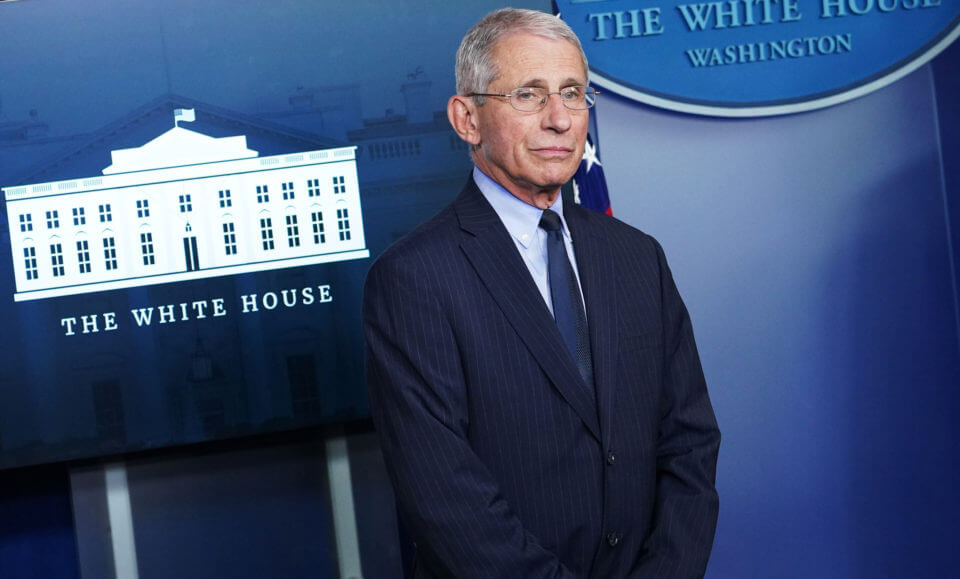
“Since a vaccine is years away, natural herd immunity is the only remaining feasible route. But current governmental actions are directly preventing the development of widespread immunity, thus guaranteeing the prolongation of the pandemic.”
Dr. Anthony Fauci, the leading expert in the federal government’s COVID-19 pandemic response, recently declared that he does not understand why all states in the United States have not imposed lockdown orders. A point-by-point analysis reveals why that approach may be a key mistake in an errant response to the coronavirus outbreak. The United States’ pandemic plan—like that of most of the world—has been counterintuitively counterproductive.
In the long run, it would be rational and correct for everyone to cower at home if (a) we could protect the population by doing so, and if (b) COVID-19 would disappear by the time people stepped out again. In the short term, it makes sense to have a population shelter-at-home if and only if an area’s healthcare system would otherwise be overwhelmed.
What are the facts? Yes, anyone sheltering at home and not interacting with other humans is obviously very unlikely to either acquire or spread the COVID-19 infection. But no one—not a single expert anywhere—believes the SARS-CoV-2 virus will disappear. This pathogen has the particular characteristics that make its outbreak unstoppable: Symptoms are not immediately evident and often mild at first, and it is easily spread by both symptomatic and asymptomatic infectees. It’s too late to quarantine this virus into submission. It’s in the wild now, and it will—in all likelihood—eventually infect most humans on the planet who interact in society, much like measles and influenza before it. This will not all happen with the current wave, but , ultimately, it’s inevitable.
So we are left with only the short-term benefits of forced isolation. Shelter-at-home for everyone is appropriate when there are not enough intensive care beds and ventilators for the anticipated need. In this light, has the United States responded appropriately?
California: Case in Point
On March 19, 2020 California Governor Gavin Newsom issued his first stay-at-home order. At that time, there were just under 800 confirmed COVID-19 cases in the state. California then had 72,473 general acute hospital beds and 7,274 intensive care beds, with additional surge capacity on the way. As of April 8, the number of confirmed COVID-19 cases in the state was 18,535, with 485 reportedly related deaths. The peak of cases is expected in less than three weeks, at the end of April. We in the medical profession are still waiting for the big crush of critically ill patients in California. It won’t come now, of course, because of Governor Newsom’s order.
You can bet that Governor Newsom will at some point declare victory. But what is actually being accomplished? (1) The inevitable is being delayed. Since the virus cannot be stopped, it will start spreading again as soon as shelter-at-home orders are lifted and people start mingling again. (It may take a short break in the summer; no one knows.) Secondary wave(s) will come, leading to more lockdowns and—unless something changes—more economic devastation. (2) The shelter orders came too soon and have worked too well. The result is that we are nowhere close to effective herd immunity* in California — nor anywhere else where early draconian measures were taken. (3) Worst of all, there is no chance for herd immunity to develop so long as premature blanket shelter orders exist.
And this exercise in futility is happening in most places around the planet where excessive isolation rules have been propounded — potentially an epic, worldwide mistake.
(*Note: In the case of COVID-19, it has been estimated that reasonably effective herd immunity — the point at which pandemics stop spreading — can be accomplished when approximately 60% of the population is immune. That percentage will rise if the virus is found to be more infective than current estimates.)
Mortality and Luck
When dealing with a viral pandemic of a relatively mild respiratory disease that spreads easily but has a low mortality rate (expected to settle at around 0.1%, much like the flu), for which there is no vaccine and none expected for about two years (probably longer) — the only rational option is to allow natural herd immunity to develop. (See what Sweden, Iceland, and a few others counties are doing, below.) Short of keeping the population at home permanently, that is the only way to stop the pandemic and the best way to protect the ones most likely to die if infected.
What is clear is that humanity got lucky with COVID-19, compared to what might have been.
But it is not possible to protect everyone. Unfortunately, some will die. It’s the natural order of things. The world loses some 56 million souls every year in normal, non-pandemic times. In the United States, approximately 8,000 people die each day (from all causes), normally. COVID-19 will cause a rise in deaths in the near term, but, after the pandemic slows down, we will likely see a significant drop in the death rate. This is because many who succumbed to this infection would have soon passed for other reasons (i.e. heart disease, diabetes, cancer, some other respiratory illness, et al). In the end, the final longer-term tally of deaths for the period encompassing the pandemic and the months following it will probably be only a little above normal.
We are fortunate that COVID-19 is, for most people, such a mild illness and that it preferentially impacts the weakest among us. The 1918 Spanish flu pandemic was not so kind to humanity. Some 50–100 million people died worldwide, mostly the young (20–40 years of age) and healthy. (A leading theory for that reverse age disparity relates to prior antigenic exposure — the older population at the time may have developed partial immunity through exposure to an earlier related pathogen.) Viruses don’t always selectively target the old and infirm. It’s much more complicated than that, and we are far from understanding it all. What is clear is that humanity got lucky with COVID-19, compared to what might have been.
Despite that, politicians worldwide have joined forces to demolish the economy of the planet, throw millions out of work, burn up trillions of dollars worth of assets, and cause panic, fear and destitution on an immense scale — all due to a basic misconception regarding the natural long-term lifecycle of this pandemic.
(Note: It has been theorized that the COVID-19 virus may have originally circulated in humans for months or years prior to its mutation and outbreak in late 2019. If true, that would greatly complicate the analysis of serology data from recently-approved blood tests. Once again we see how wrong we might be in our current understanding of the pandemic.)
Unintended Consequences
The human cost of all the overreactions and fear-spreading we have seen to date will be enormous. With the country shut down, millions of people who normally live paycheck to paycheck are left with no resources. Many will be unable to buy food, let alone pay for health insurance or find their way to a medical provider. Many others will get infected by their children, now at home 24/7 due to school closures. (Children are most likely to be asymptomatic carriers and spreaders of SARS-CoV-2.) Some will go to work sick, believing they have no choice. It is not at all clear that the aggressive measures we have seen to date will in total save lives; through unintended consequences, the opposite could happen. (One example: by forcing children to stay home with their elders, we may be increasing the rate at which the most vulnerable among us are infected.)
The question that must be addressed is: What is the point of shutting down the economy as we have? Since the spread of the virus is unavoidable, the only valid reason is to avoid healthcare system overload. But that risk currently exists in only a handful of areas in the country. And in any event, all lockdowns are by definition temporary. When those orders are lifted, the pandemic will return in wave after wave until and unless one of two things happens: either an effective (and safe) vaccine is widely distributed, or sufficient herd immunity is achieved. Since a vaccine is years away, natural herd immunity is the only remaining feasible route. But current governmental actions are directly preventing the development of widespread immunity, thus guaranteeing the prolongation of the pandemic.
Special areas require special precautions
New York City, with its extreme concentration of people from all over the world, is a special case requiring special protections, as are some other similarly at-risk locations around the world. Within the United States, only the greater New York City area, New Orleans, and a few other locations clearly require the consideration of strong social isolation rules.
Most areas are like California, where there is no looming shortage of healthcare capacity and the early lockdowns have been almost entirely counterproductive — postponing the inevitable, devastating the economy, and preventing the building of natural immunity.
The lesson: even if you fight the virus correctly, without harsh measures, you can still over-flatten the curve by blocking the spread of natural immunity.
Some countries have found better solutions:
- South Korea and Taiwan started their pandemic response almost immediately. They were able to flatten the curve, while refraining from imposing draconian rules by, instead, implementing aggressive testing and patient tracking using multiple advanced technological tools. These countries allowed near-normal free mobility while providing intensive education and rules on hygiene and social precautions. They also quarantined known cases and protected the most vulnerable (elderly and infirm). They did not shut down their economies and have, nevertheless, succeeded in controlling the spread of the virus, while allowing natural immunity to build. Taiwan did it despite its extreme proximity to the pandemic’s epicenter in China. Note: As an early warning sign for the rest of the world, South Korea may already be seeing indications of a possible second wave of infection. The lesson: even if you fight the virus correctly, without harsh measures, you can still over-flatten the curve by blocking the spread of natural immunity.
- Sweden is doing what the United States should have done. They’ve avoided the shutdown of businesses and eschewed widespread lockdowns and shelter-at-home orders. Public education on hygiene and basic precautions has been intense. Only recently have large gatherings (>50 people) been banned. Despite disagreement from some scientists in and out of the country, Sweden’s results so far have been in line with other European countries and significantly better than those of the United States.
- Iceland has done more testing per capita than any other country, and the results have been illuminating (e.g., they’ve found that about 50% of COVID-19 infectees are asymptomatic). As a result of their extensive testing, Iceland’s COVID-19 mortality rate is a mere ~0.2% — fast approaching the previously noted likely endpoint of 0.1%. Iceland’s approach has been similar to that of other successful countries: test aggressively, isolate known cases, and diligently track contacts, provide intensive education on hygiene and personal precautions, and avoid broad economic shutdown and lockdowns. It’s working.
- The Netherlands has taken an interesting middle-of-the-road approach. The country is aiming to allow the development of herd immunity with only partial lockdowns (schools, bars, restaurants, hairdressers, etc. are closed, while other businesses, including most “non-essential” ones, remain open). Prime Minister Mark Rutte recently said: “What I hear around me is that people are glad that they are treated as adults, not as children.” He’s taken some flack, but so far the policy is working.
Given the relatively sanguine results from countries that have neither closed all businesses nor propounded harsh lockdown orders, why have the United States and so many other countries in the West demolished their economies and created so much misery and panic?
Why Has the United States Gotten It So Wrong?
The primary factor that has led the United States astray is the politicization of the pandemic response. The Right underplayed it at first, with the Trump administration failing to ramp up necessary testing capacity. The Left then started gleefully attacking the Right, often exaggerating the severity of the crisis. Meanwhile, politicians rushed to the microphones to show how strong and proactive they are, declaring draconian rules across the country. This is an election year, after all. And COVID-19 is a juicy target to be readily attacked with seemingly clear plans — unlike the myriad other problems our society faces (climate change, homelessness, healthcare, obesity, etc.).
Compounding all the mistakes is the ubiquitous nature of modern media, which envelops us 24/7 these days and which is too often motivated more by profits than reason.
Then, there’s the faulty data underlying the overreactions: (a) The initial undercounting of total COVID-19 cases (the denominator of the mortality rate fraction)—caused by insufficient testing capacity—inflated the reported mortality rate of the disease, frightening everyone. (b) Less well-known is that there is also a very significant overcount of the number of pandemic-related deaths (the numerator). If someone is diagnosed with COVID-19 and then dies accidentally, or is killed iatrogenically (by medical error —estimated to cause hundreds of thousands of deaths annually in the U.S. in normal times), that can be counted as a pandemic-related death. The actual cause of death may not matter: If you’re COVID-19 positive and die of any cause, you can be counted. Italy has the same problem. (Note: This is the opposite of China, where the government works to minimize COVID-19 counts in various ways, for political purposes. This is why China’s data are not considered reliable.)
There is a valid reason for the overcount of pandemic deaths: The CDC cannot rely on attending physicians’ certificates, which are often inaccurate or incomplete. So they believe it’s better to overcount than undercount. But the fact remains that the reported number of COVID-19-caused deaths is always significantly overstated, in most of the world.
And while reported mortality rates will continue to drop as testing capacity grows (because the total number of known cases — the denominator — will rise to better reflect reality), the overcount of pandemic-related deaths (the numerator) will never be fixed. I.e., the reported mortality rate will always be higher than the true rate. This built-in exaggeration of COVID-19’s kill rate leads to fear, panic, and overreaction.
What We Should Be Doing
Our goal should be to allow the virus to spread so that most people develop immunity to it, while limiting the numbers only as needed to prevent healthcare overload. This may be a tricky balancing act, but it’s necessary. The current plan of indiscriminately locking everything down is wrong and highly destructive. We are ruining our economy and creating widespread misery, while only delaying the inevitable and prolonging the pandemic.
We must all follow the law, yet it’s important to get the truth out. To that end, here is what I believe we should be doing:
- Rescind shelter-at-home orders and open up most businesses in all areas except the few where the danger of healthcare overload is clear. At the same time, we need to continue instructing the public on basic hygiene and personal protective measures. This has worked in several countries around the world, and it would work in the United States too, especially now that testing capacity is finally reaching adequate levels.
- Track the spread of COVID-19 carefully, test extensively (especially with the newly-approved serology tests), and adjust the rules as needed if/when hot spots appear. The goal of any stay-at-home order should only be to prevent healthcare system breakdown. Stopping the virus is impossible, so stop trying. Remember that in the absence of a vaccine, excessive isolation rules will only create secondary waves of this pandemic. This is in addition to the obvious economic devastation. The second wave risk continues until and unless sufficient herd immunity is built.
- Continue to increase healthcare capacity and ventilator counts as rapidly as possible.
- I advise my patients that the best defense against any infection is a healthy body and a properly-functioning immune system. To that end: Don’t smoke; Get enough sleep (sleep deprivation weakens the immune system); Work with your doctor to get off all unnecessary medication, especially those that suppress the immune system (the most common of which are the statin cholesterol medications); Stop all junk food, including junk drinks; In the context of a complete nutritional support program, make sure you get adequate amounts of these nutrients: Vitamins A, C, and D, plus zinc and selenium; Stay well-hydrated.
Politicians have too many ulterior motives to be making medical decisions for millions of people. We should do something about that.
Finally, someone with some acknowledged authority, please stand up and tell the American people to stop embarrassing themselves with all the hoarding going on now. While you are scrounging for toilet paper, approximately 25,000 people die from hunger in the world every day. No pandemic necessary. Please, let’s find some balance.
Joshua Leichtberg, M.D. is a medical doctor specializing in internal medicine and is based in Southern California.












Thank you very much for bringing a well balanced, honest and humane view to a situation that seems to be dividing people. Fear seems to have (understandably) triggered people into limbic reactions and suppressed higher cognitive reasoning. Thank you for your level-headed truth !